
Google has come a long way since its inception, transforming near-daily to provide a better experience to its users. As the Internet keeps moving towards mobile, search engines like Google are working overtime to ensure that the results users get are exactly what they need. This means the introduction of new features on their search engine result pages, which introduces a problem for SEO professionals: how do we take advantage of those features to keep ranks high and boost traffic?
Today, we’re going through the best SERP features that you need to pay attention to and consider for ecommerce seo in order to stay at the top of result pages.
What are SERP Features?
SERP is an abbreviation of the term “search engine result page,” referring to the page listing all results for a specific search query. Since it’s inception, Google has been constantly adding and changing their SERPs to improve the user experience and help searchers access better, more effective answers faster. SERP features are one of the main ways that Google accomplishes this, presenting structured data to users in a way that makes SERPs easier to navigate and more helpful.
Google’s work is never done when it comes to improving user experience, leading them to create new SERP features as recently as last year with the introduction of FAQ results and How-To results. Since SERPs are always changing, so are SEO best practices, meaning you’ll need to keep up on every new update to stay ahead.
Best Google SERP Features & How to Use Them
Not all SERP features are created equal – some are more beneficial for certain industries, so it’s important to determine which features to focus on in your unique SEO strategy. Let’s dive into the most important SERP features for boosting traffic to your site and how you can optimize for them.
Featured Snippets
As questions become a more popular form of query, especially with the advancements in voice search, Google introduced an easy way for users to find the answer quickly without having to navigate to a website. Appearing in the first SERP position (even before rank 1 search results), featured snippets are designed to give searchers specific answers to their question-formatted queries.
Typically, the answer in the featured snippet is taken from one of the top 5 results on the first page – not always the first organic result. Because of this, it can be possible to usurp the coveted first rank by gaining the featured snippet.
Featured snippets can appear as paragraphs, bulleted/numbered lists, tables and more within 40-60 words.
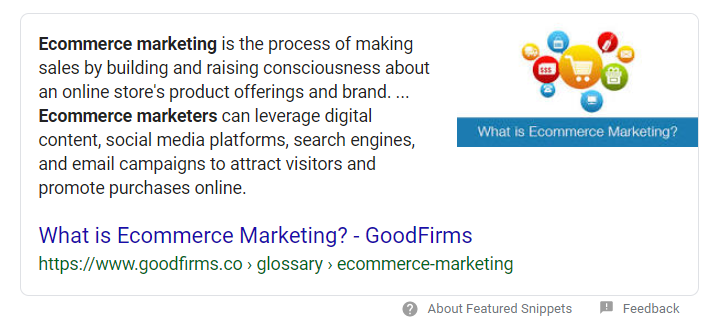
How to Use Featured Snippets
In order to gain the featured snippet on your target keyword, you should already be ranking within the top 5 results on that SERP.
Once you’ve achieved this, you’ll need to focus on using structured data, such as schema organization markup, so Google can understand your content better and determine whether it should be in the featured snippet. Don’t forget to mark up visual content too – images often enhance the result preview.
Regarding the snippet content itself, be sure to answer your target keyword question effectively within 40-60 words. To get ideas for what your content should look like, check and see if your target keyword already has a featured snippet so you can understand what Google is looking for.
Rich Snippets
Displayed between a search result’s URL and meta description, rich snippets are additional pieces of context for products, businesses, and more. There are several different types of schema that can be included in rich snippets, including:
- Product Details: This can include images, prices, brands, availability, sale prices, etc.
- Reviews & Ratings: Usually shown in the form of a star rating out of five and/or a numerical rating out of 10.
- Video Schema: Found under video results, this can show the video’s upload date and channel.
On mobile, rich snippets take the form of a Mobile Rich Card. This card format works effectively the same as normal rich snippets and is only optimized visually for mobile devices.

How to Use Rich Snippets
Thankfully, rich snippets are one of the more low-effort SERP features to take advantage of. To get rich snippets on our results, you’ll need to add schema markup to any information that you want to show up. That includes properly marking reviews, prices, product availability, and anything else you’d like users to see. Once your search results are decked out with rich snippets, you’ll stand out on SERPs and garner new eyes to your site.
People Also Ask (Related Questions)
Related Questions panels, labelled as “People also ask,” usually show up when a searcher enters a question as their search query. The related questions are most often follow-up questions to the original query, giving more information to the searcher in a drop-down list format.
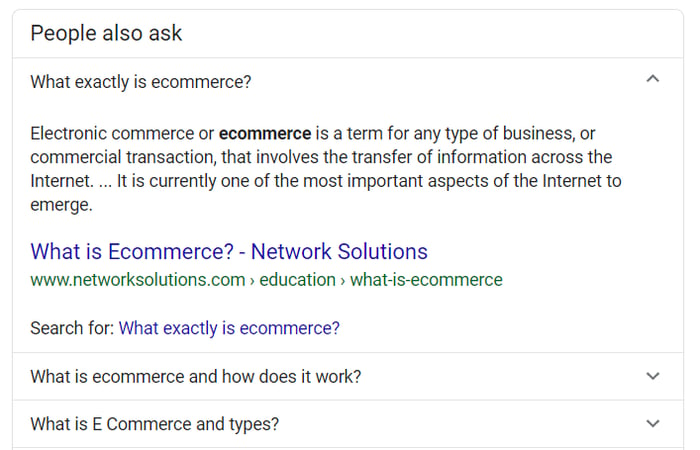
How to Use “People Also Ask”
In order to get your content and, therefore, your site featured in the Related Questions feature, then you’ll need to first make sure that you’re already ranking in the top 10 results for your target keyword. Like featured snippets, related questions typically pull their questions and answers from pages ranking within that first 10.
You’ll also want to make sure that you’re ranking for both the target question keyword and related questions so that Google can make that relevance connection and feature your page.
When it comes to the content you need to be optimizing for, be sure to answer specific questions or define certain key terms. Work to determine what information that searchers need when they’re already asking the target keyword question and build off of that information to create your content. A great way to accomplish this is through an FAQ page or knowledge base.
Knowledge Graph & Panel
Knowledge Graphs appear on the right side of a SERP when users search for famous people or organizations. This SERP feature pulls content and data from publicly available information, such as Wikipedia, the CIA World Factbook and Wikidata.
Knowledge Panels, on the other hand, appear in the same area of the SERP when a user searches for a brand. The information in a Knowledge Panel is pulled from company websites, Google Maps, and/or business directories. Since this feature is focused on companies that provide a service, reviews and ratings are also sometimes visible in the card.
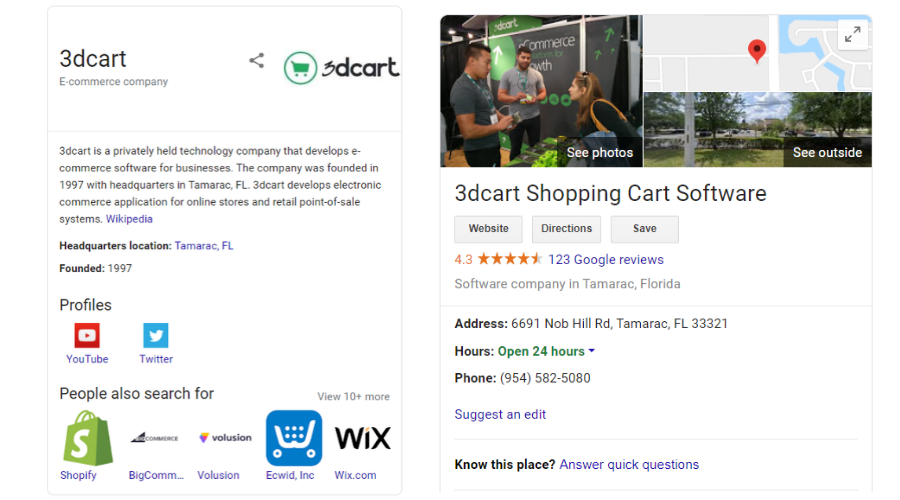
Pictured: Knowledge Graph vs Knowledge Panel
How to Use Knowledge Graphs & Panels
While it’s much more difficult to control what information is presented in a Knowledge Graph than a Knowledge Panel, it’s still a good idea to submit your business to Wikipedia with a link to your Wikidata so that there’s information for Google to pull from.
Taking advantage of Knowledge Graphs and Panels comes down to keeping information about your brand up-to-date. This means that your branded website’s pages should be complete and accurate, in addition to off-site information in Google’s Index, business directory listings, verified social media profiles and anywhere else that your business may be discussed.
As always, you’ll want to make sure that you’re using the proper organizational schema markup on your web pages so that Google can properly understand your content for listing.
Local Pack
If you run a brick-and-mortar location, you’ll need to optimize for Local Packs. Intended for users searching for establishments “near me”, the Local Pack is a SERP feature that caters a list of locations that may be relevant to the search. This often includes restaurants, hospitals, and any other commercial or travel oriented location. The main three criteria for determining what businesses show up in a Local Pack are distance, prevalence and relevance to the search query.
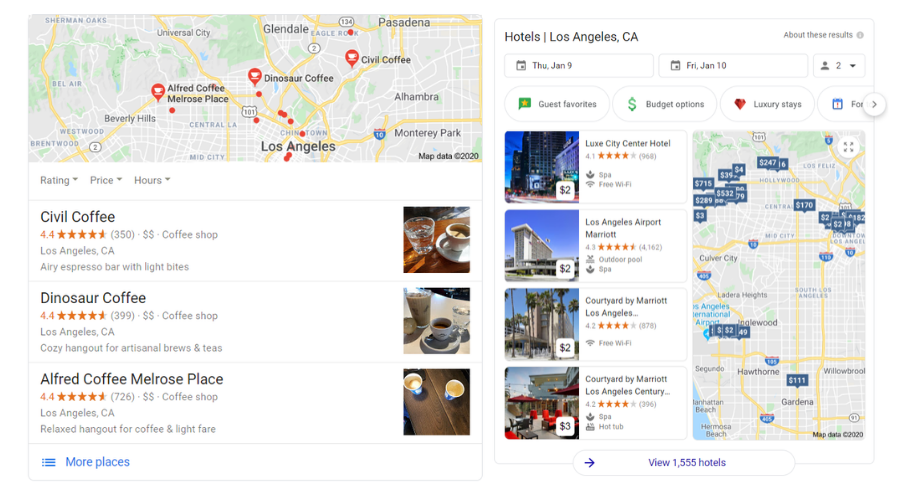
Pictured: Local Pack vs Local Teaser Pack
The Local Teaser Pack is an extended version of the Local Pack that features more actionable information, such as hours, reviews pricing, and more. Certain types of locations with see added features to their Local Teaser Pack entry depending on their industry – for example, results for hotels will show room prices, vacancy dates, etc.
How to Use the Local Pack
First, you should determine which search results are displaying local SERP features so you know what target keywords to optimize for. If you’re already optimizing for local SEO, then you may be aware of these targets already.
By adding your business to online directories like Yellow Pages, Yelp, and Google My Business, search engines will have an easier time finding accurate information about your location that can be displayed in the Local Pack.
Optimizing for mobile should already be a priority, but it’s especially crucial when trying to appear in local results. Since most users searching “near me” queries intend on travelling to a physical location, they’re almost always searching on their mobile devices. Google takes this into account, staying in line with their user experience priorities.
Like all other SERP features, you’ll need to make sure that your site is marked up with schema organization so that Google can easily determine your store’s location, name, and phone number.
Image Pack
When users search for a query that’s best answered visually, Google delivers the Image Pack. This SERP feature appears as assorted image thumbnails in a horizontal carousel, acting as a preview for more images related to the search query. Image Packs are especially relevant for real estate businesses, tourist websites, and any organization that relies on visuals.
One unique feature about the Image Pack is that it’s a SERP feature that isn’t locked to a specific spot on the SERP – the carousel can show up at the top, middle or bottom of the page.
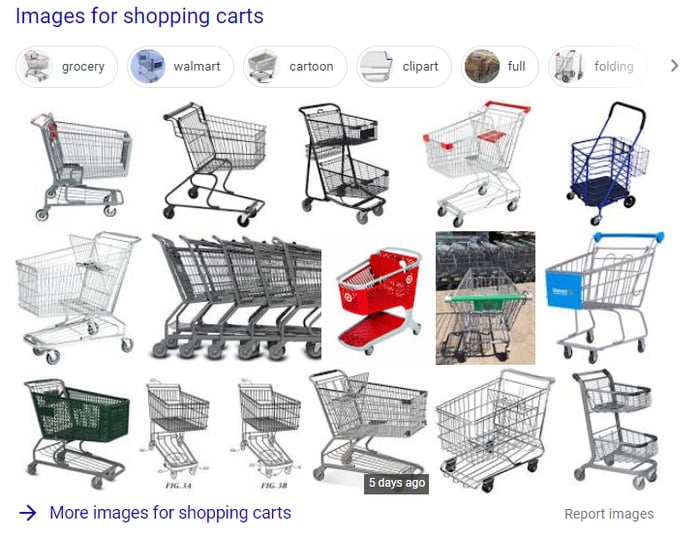
How to Use the Image Pack
To appear in the Image Pack, you should work on following established best practices for image SEO. These include:
- Using descriptive alt text and file names
- Including target keywords in title tags and file names
- Optimizing on high-quality images
- Crafting user-friendly URLs
Like always, ensure that the pages your images are hosted on are properly marked up for schema organization as well.
Site Links
Appearing directly underneath a normal search result, Site Links is an expanded list of direct links to your website’s most important sub-pages. Typically, this includes pages like About Us, Blog, Contact Us, Product Categories, Help Center, and more.
One of the more notable aspects of the Site Links feature is that it takes up so much space on the SERP, dominating the page and making your website’s search result stand out and draw user’s attention. Suddenly, you’re not ranking with just one URL – you’re ranking with 4 additional URLs that lead to major pages on your site, boosting traffic through the roof.
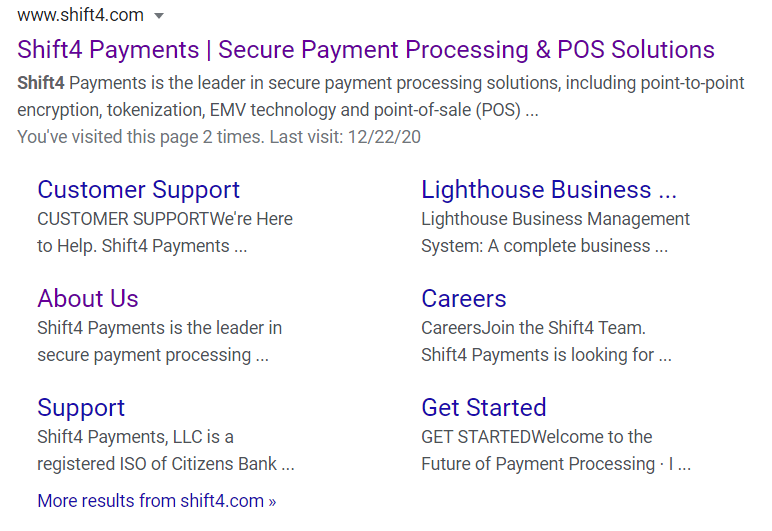
How to Use Site Links
To earn Site Links below your site’s main search result, you’ll first need to make sure that your site has good navigational structure and hierarchy. If Google can’t easily navigate your site’s sub-pages, they won’t consider listing your sub-pages. Focus on internal linking to emphasize the relationship between your pages and their context within your overall site.
You’ll also want to submit your accurate, up-to-date sitemap to the Google Search Console. This gives Google the clearest understanding of your website’s layout and pages. And, as per usual, ensure that you add the correct schema markup to your site to further assist Google in determining your Site Links.
Top Stories (News Box)
Formerly known as the News Box, the Top Stories SERP feature includes time-sensitive, trending news stories related to a search query. These stories appear on the SERP as horizontal cards at the top of the page and will display the headline, publisher and publish date. Content that qualifies for a spot in Top Stories includes:
- Blogs
- Press releases
- Opinion/editorial
- Satire
- Breaking news
- Subscription-based articles
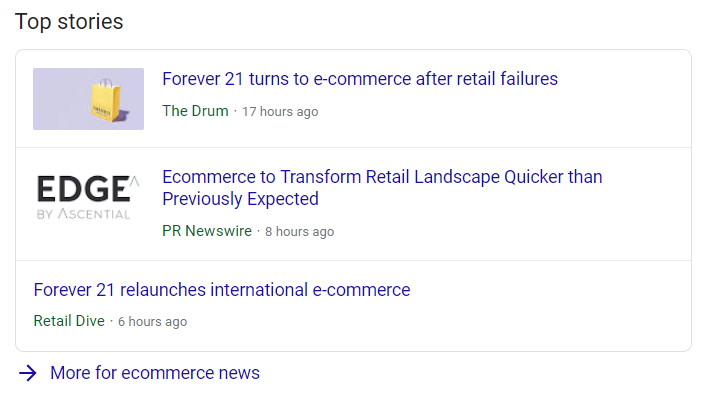
How to Use Top Stories
To appear in Top Stories, you’ll need to follow the Google News submission procedures and request for your content’s inclusion. Your desired content should be original, transparent, accurate, easily readable and timely.
You’ll also want to make sure that your site and its pages are optimized using AMP, which stands for accelerated mobile pages. Google prefers suggesting websites that are optimized for mobile users, so working this into your strategy will boost your chances of earning that spot. Like all other SERP features, your content should be properly marked for schema organization.
Video Snippets
Displayed between other organic text-based results, Video Snippets have the added features of a video thumbnail, video title, link, upload date, channel username and more. Video Snippets can show up on SERPs either in a 3-pack or a single featured video.
The Featured Video Snippet differs from typical Video Snippets because it features a larger thumbnail and additional info. The Featured Video also always appears at the top of the SERP.
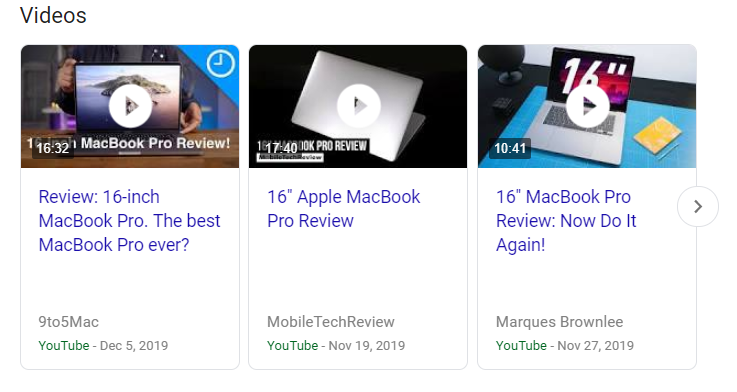
How to Use Video Snippets
While Video Snippets aren’t going to include direct links to your website, they’re still useful for driving traffic in the long run. Include CTA’s and cross-links to your site in videos from your company’s YouTube channel. By grabbing their attention with a Video Snippet, you’ll gain viewers that may be interested in learning more.
To get your videos featured as Video Snippets, you’ll want to optimize using traditional YouTube best practices for titles, descriptions, categories, tags, and more. You’ll also need to follow specific video schema markup guidelines from Google to help the search engine find and understand your content.
Twitter Snippets
Usually triggered by branded search queries, Twitter Snippets appear on SERPs as a carousel of the three most recent tweets from a specific account or brand. The tweets show up in card format, allowing the searcher to scroll to the right to show more tweets. Each tweet card will show the tweet’s text and date.
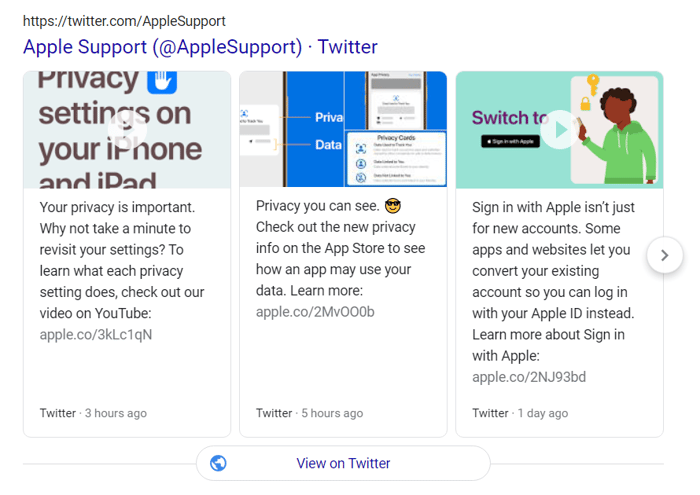
How to Use Twitter Snippets
While Tweet Snippets won’t directly link to your site, they boost brand authority and drive users to check out your social media presence. From there, be sure to follow social media best practices and make your website’s URL prominent in your Twitter bio.
Most Twitter Snippets seem to display tweets from verified users with high engagement and followers, so maintain an active presence on your account and get verified as soon as possible.
Paid Features
So far, we’ve covered all of the best organic SERP features for boosting traffic to your site. But Google also offers a selection of paid SERP features that may serve to be effective in a PPC strategy.
AdWords Top & Bottom

Google ads promoted through AdWords can be featured at the top and bottom of SERPs with a green “Ad” label that clearly informs searchers that the entry is appearing as a paid ad. To cut down on how many ads are generated at the top of SERPs for competitive keywords, they’ve split ads between the top of the page and the bottom of the page. Google determines which ads gain the top or bottom spot based on the following factors:
- Google Ads quality scores
- Bidding amount
- Relevance
In order to start an AdWords campaign, you’ll need to create an account, create your first campaign, determine your target keywords and calculate your budget.
Product Listing Ads (PLA)
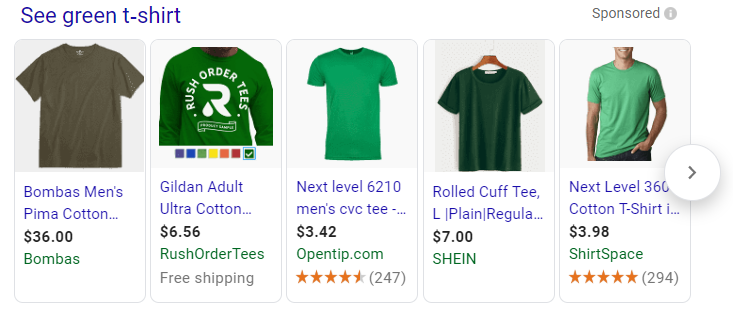
Also called Google Shopping Ads, PLAs are triggered by transactional queries with high purchase intent. These ads will usually appear at the top of the SERP and feature a small “Sponsored” tag to clarify to searchers that the product cards are paid ads.
PLA’s appear in a carousel of cards, with each card showing the product’s name, price, website name, product image, and more depending on the information you provide to Google. Due to the visual nature of these ads, they’re more useful in driving traffic than the text-based AdWords listings.
In order to get your products displayed as PLA’s in Google Shopping results, you’ll need to create a Google Merchant Center account and create ads for your products. For more details on signing up, check out our guide to Google Shopping.
Wrapping Up
If your SEO strategy isn’t constantly evolving alongside search engine advancements, then it’s time for you to change things up. What worked last year won’t keep working forever – especially at the rate of which Google is updating their SERPs and introducing new ways for searchers to find what they’re looking for. To make sure that the answer to user questions keeps leading back to your website, keep changing your strategy and introducing new ideas so that Google recognizes your brand as one to feature.


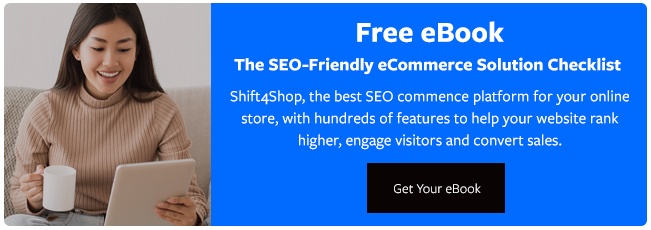


Leave a reply or comment below